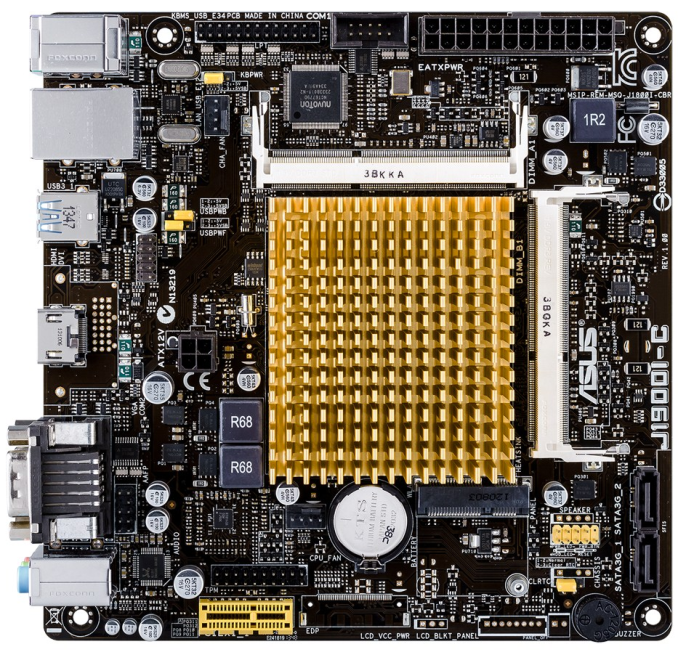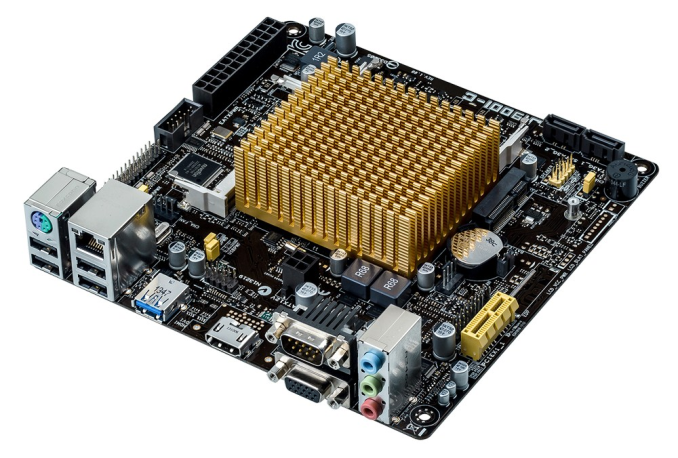The Battle of Bay Trail-D: GIGABYTE J1900N-D3V and ASUS J1900I-C Reviewed
by Ian Cutress on October 17, 2014 10:00 AM ESTASUS J1900I-C Visual Inspection
The implementation of J1900 from ASUS differs a fair amount from GIGABYTE. Taking the board out of the box and the first thing to notice is the DRAM placement – instead of stacking one above the other, the modules are arranged such that one is above the SoC and one is to the right. There is still enough space for standard sized modules in both of these slots, and ASUS has even placed a fair amount of electronics underneath as well – the top DRAM slot has the Nuvoton SuperIO IC in that area, for example.
Similar to GIGABYTE, the motherboard has only two fan headers. The CPU header is below the socket beside the CR2032 battery, with the CHA header just to the left of the DRAM slot at the top. Both of these headers are 4-pin as well.
ASUS has prioritized different connectors around the edge, with the LPT header and COM header having priority at the top over the 4-pin CPU power connector which has a spot just to the left of middle nearer the SoC. This is an abysmal place for a 4-pin CPU power connector as it means any cable has to stretch over most of the board in order to reach. While making a neat layout might not be the ultimate goal for anyone using a Bay Trail motherboard, having this connector here might still disrupt airflow over the passive heatsink.
On the right hand side of the motherboard are our two SATA ports with the front panel header in yellow beside them and the internal buzzer nearby. The mini-PCIe port also rests in this bottom right corner beside the battery. Another difference to the GIGABYTE board will be the extra slot at the bottom – where GIGABYTE used a PCIe to PCI bridge, ASUS has implemented a PCIe 2.0 x1 slot instead. Perhaps unfortunately this is a closed ended PCIe 2.0 x1 slot, meaning that larger cards cannot be used. Above this is a TPM header.
Also on the board is the front audio header, powered from a Realtek ALC887-VC audio codec, and a USB 2.0 header behind the USB 3.0 on the rear panel.
The rear panel looks a bit bleak compared to the GIGABYTE, but this is because ASUS has decided to only use one COM header here and we get HDMI rather than a DVI-D. There is also only one network port, and the PS/2 connector is a joint connector. Where GIGABYTE uses a USB 3.0 hub to have four USB 3.0 ports, the J1900I-C only has one and four USB 2.0 ports instead.
Board Features
| ASUS J1900I-C | |
| Price | Link |
| Size | Mini-ITX |
| CPU Interface | Soldered |
| Chipset | Bay Trail-D Quad Core |
| Memory Slots | Two DDR3L SO-DIMM slots supporting up to 8GB Up to Dual Channel, 1333 MHz |
| Video Outputs | VGA (2560x1600 at 60Hz) HDMI (1920x1080 at 60 Hz) |
| Onboard LAN | Realtek 8111G |
| Onboard Audio | Realtek ALC887 |
| Expansion Slots | 1 x PCIe 2.0 x1 1 x Mini-PCIe |
| Onboard SATA/RAID | 2 x SATA 3 Gbps |
| USB 3.0 | 1 x USB 3.0 (SoC) [rear panel] |
| Onboard | 2 x SATA 1 x USB 2.0 Header 1 x LPT Header 1 x COM Header 1 x TPM Header 1 x mini-PCIe 2 x Fan Headers Front Panel Header Front Audio Header |
| Power Connectors | 1 x 24-pin ATX 1 x 4-pin CPU |
| Fan Headers | 1 x CPU (4-pin) 1 x CHA (4-pin) |
| IO Panel | 1 x PS/2 Combination Port 4 x USB 2.0 Ports 1 x USB 3.0 Ports 1 x Realtek Network Port HDMI VGA 1 x COM Port Audio Jacks |
| Product Page | Link |
One might ask why the J1900N-D3V costs less than the J1900I-C and yet has two NICs and four USB 3.0 ports. The J1900I-C combats this with a HDMI port (which will arguably be preferred), have a total of six USB 2.0 ports and a PCIe 2.0 x1 port, which should also be more versatile.













60 Comments
View All Comments
Flunk - Friday, October 17, 2014 - link
Yes, but that's like comparing a man with two broken legs to a man with no legs. Yes, the man with the broken legs is faster, but neither is going to be competing in any footraces anytime soon. These are not really suitable for PC gaming.Slap the two of them into tablets and the AMD will run Candy Crush better, but this is the desktop and neither can really manage anything on that level.
AJSB - Friday, October 17, 2014 - link
I said *LIGHT* gaming....i also specified a certain resolution up to 1366x768 (forget about 1920x1080).It all depends the kind of titles it plays....many indies will play just fine...and so it will MANY of the "old" titles like CoH (NOT CoH2), CoD2, BF2,etc. at those resolutions....lot's of people still play at least CoD2 online (and doesn't have those crazy UAV/HELIs in MP) and theres lots of mods for CoH and BF2 to play online or offline (i actually prefer play those offline).
Having said so, i play with a A6-5400K OC to 4GHz w/ iGPU OC to 950MHz and 8GB RAM at 2133MHz (CPU, iGPU and RAM were all undervolted to cut temps and power drain).
This rig gives me more freedom to play more demanding titles that i doubt a AM1 could.
PICman - Friday, October 17, 2014 - link
As usual, good review. However, as XZerg pointed out, the lack of idle and load power consumption is a problem. It's not just power consumption, but also heat generation and cooling. I guess the tests were run with a high wattage power supply, making idle power measurements meaningless?Non-working USB 3.0 ports is a big issue for me, also.
Torpe - Friday, October 17, 2014 - link
How well do these chips do with Quick Sync for Handbrake?Devo2007 - Saturday, October 18, 2014 - link
Did you read the part that mentioned these are the B3-stepping processors that don't have QuickSync?abufrejoval - Tuesday, October 21, 2014 - link
My GIGABYTE J1900N-D3V wasn't properly informed about that "fact" and just runs QuickSync anyway... Actually the initial Intel chipset drivers didn't enable QuickSync and I was quite hopping mad, because ARK had reported QuickSync support for the J1900, irrespective of the stepping.Actually I believe that the QuickSync feature gap lies between the J1850 and the J1900 and isn't stepping dependent.
abufrejoval - Tuesday, October 21, 2014 - link
Need edit!Fortgot to mention: It's a B3 stepping and runs around 80 frames/sec of DVD to MP4 conversion using DVDFab9 using QS. The QuickSync enabled Handbrake nightly builds I tried produced faulty output and the last stable release doesn't yet support QS.
Batch video conversion isn't exactly the forte of this device, but it would make it a credible Plex server once QS support for encoding is built in (for devices that need the run-time conversion).
Torpe - Tuesday, October 21, 2014 - link
Thanks for the answer.BillyONeal - Friday, October 17, 2014 - link
Windows 7 needs USB 3 drivers because Win7 has no USB 3 support. That was added in Win8.nathanddrews - Friday, October 17, 2014 - link
"Readers of our motherboard review section will have noted the trend in modern motherboards to implement a form of MultiCore Enhancement / Acceleration / Turbo on their motherboards."It's funny the difference between what turbo means today vs what it meant 30 years ago. My first PC (running Geo-DOS) had a "TURBO" button on the case that slowed it down. LOL
I've been using a Windows 8.1 (Bing) tablet with an Atom Z3735D and it's really impressive. It plays UT99 and Halo CE flawlessly at max res and settings (1280x800) and can stream games over Steam IHS. I played Halo for four hours nonstop and still had 30% battery left.